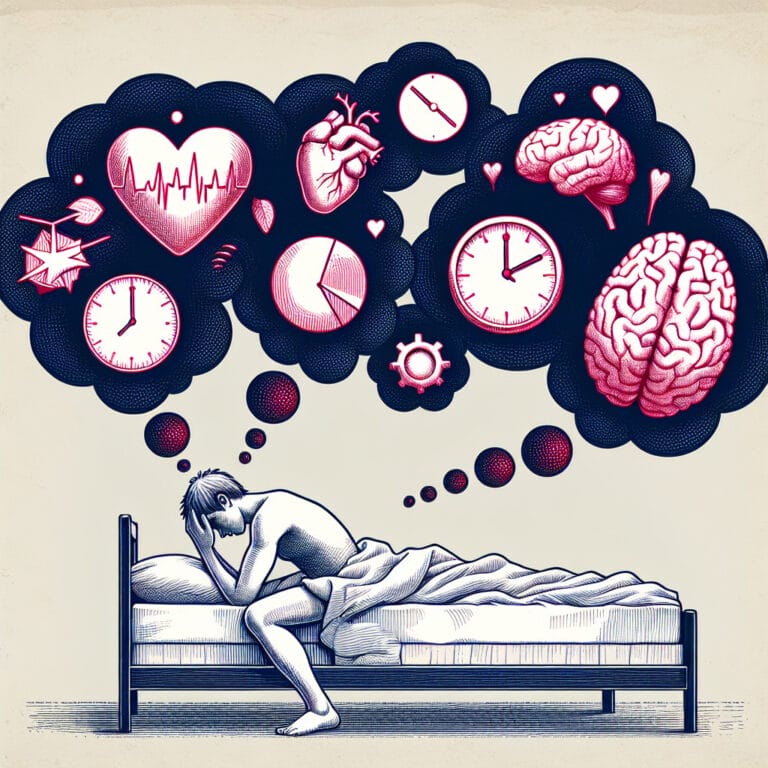
Understanding Sleep Onset: Definition and Insights
Table of Contents
- Introduction
- The Science Behind Sleep Onset
- The Impact of Sleep Onset on Health
- How to Improve Sleep Onset
- Conclusion
- Frequently Asked Questions
Introduction
Understanding the intricacies of sleep onset, that point in time when we transition from wakefulness to sleep, is vital, especially given its influence on our overall health. This process involves a complex interplay between arousal-promoting neurons and sleep neurons – an equilibrium that can often be disrupted by various factors. One common manifestation of this disruption is sleep-onset insomnia, a prevalent sleep disorder characterized by long sleep latency or difficulty falling asleep. Furthermore, if your total recording time in a sleep study report shows elongated periods of wakefulness before achieving REM sleep, it may indicate a compromised capacity to fall asleep promptly and effectively treat any resultant ‘sleep debt’. Moreover, numerous clinical trials have shown that high sleep latency – the time it takes for one to transition from full wakefulness to NREM (non-rapid eye movement) stage of the sleep cycle – significantly reduces overall ‘sleep efficiency’, impacting both total amount and quality thereof. Emphasizing good daily habits like maintaining sound ‘sleep hygiene’ can potentially mitigate these issues; however, in extreme cases such as idiopathic hypersomnia where excessive daytime sleeping occurs despite longer total time in bed during night-time hours- consulting with a specialized practitioner such as a ‘sleep specialist’ might be required.
The Science Behind Sleep Onset
Diving into the intricate biology of sleep, arousal-promoting neurons and sleep neurons play a pivotal role in regulating our circadian rhythm, thereby influencing the time it takes to fall asleep or ‘sleep onset latency’. This delicate dance of neuronal activities sets the stage for one’s journey through various sleep stages, starting from light NREM (non-rapid eye movement) sleep to deep REM (rapid eye movement) sleep. In an ideal scenario, one would transition smoothly through these stages to achieve restful slumber. However, factors such as poor daily habits or inadequate ‘sleep hygiene’ can tip this equilibrium – leading to conditions like sleep-onset insomnia.
The onset of sleep is far from being a simple switch-off procedure. It’s more akin to dialing down wakefulness and allowing the body’s innate ‘sleep drive’ fostered by certain chemical processes such as adenosine build-up throughout the day, take over. Given that total amount of quality rest impacts our overall health and well-being significantly; any disruption causing longer than usual ‘sleep latency’ poses serious concerns.
Sleep disorders like idiopathic hypersomnia exhibit abnormally long periods of wakefulness before achieving REM sleep – an indication that something is amiss with the individual’s natural ability to shift between sleeping and waking states swiftly. These observations often come from meticulously compiled data within a ‘sleep study report’, conducted under controlled conditions in a specialized facility known as a ‘sleep laboratory’.
Apart from neurological aspects dictating your transition into dreamland; maintaining good daily habits including consistent bedtimes and avoiding electronics before hitting the sack ensures sound ‘sleep hygiene’. This not only helps you fall asleep faster but also improves your overall ‘sleep efficiency’, reducing potential ‘sleep debt’. But if issues persist despite best efforts, consult with a ‘Sleep Specialist’ who may recommend treatments or tests such as multiple-sleep-latency-tests for assessing daytime drowsiness severity or suggest lifestyle changes aimed to treat sleep-onset insomnia effectively. Through these measures, one can gain better control over their sleep health, aiding in the restoration of a normal, healthy sleep-wake cycle.
| Term | Description |
|---|---|
| Sleep Onset Latency | The time it takes to transition from full wakefulness to sleep. |
| Sleep Neurons | Neurons that play a pivotal role in regulating our circadian rhythm and the onset of sleep. |
| NREM Sleep | Non-Rapid Eye Movement sleep, a lighter stage of sleep from which it’s easy to wake up. |
| REM Sleep | Rapid Eye Movement sleep, a deeper stage of sleep where dreams usually occur. |
| Sleep Hygiene | Maintaining good daily habits regarding sleep, such as consistent bedtimes and avoiding electronics before bed. |
| Sleep-Onset Insomnia | A condition characterized by difficulty falling asleep at the beginning of the night. |
| Adenosine | A chemical that builds up in the body throughout the day, promoting sleepiness. |
| Sleep Latency | The duration of time it takes to transition from wakefulness to sleep. Longer periods may indicate potential sleep disorders. |
| Idiopathic Hypersomnia | A sleep disorder characterized by excessively long periods of wakefulness before achieving REM sleep. |
| Sleep Study Report | A report generated from data collected during a sleep study, often used to diagnose sleep disorders. |
| Sleep Laboratory | A specialized facility where sleep studies are conducted under controlled conditions. |
| Sleep Debt | The cumulative effect of not getting enough sleep, which can impact overall health and well-being. |
| Sleep Specialist | A medical professional who specializes in diagnosing and treating sleep disorders. |
| Multiple-Sleep-Latency-Tests | Tests used to measure the time it takes for a person to fall asleep in order to assess the severity of daytime sleepiness. |
The Impact of Sleep Onset on Health
The ripple effect of sleep onset on both physical and mental health is far-reaching, underscoring the need for timely intervention in case of anomalies. Sleep deprivation, often a result of long sleep latency or difficulty falling asleep, can trigger an array of physiological issues such as weakened immune system, heightened blood pressure and even increased risk of diabetes. On the other hand, mental health isn’t spared either; numerous clinical trials indicate a significant correlation between sleep disorders and conditions like anxiety and depression. The common form, sleep-onset insomnia presents itself as a perpetual struggle to transition from wakefulness to sleep within an acceptable time-frame. Moreover, this prolonged latency paves way for ‘sleep debt’, where the total amount of lost rest accumulates over time – further exacerbating the impact on overall well-being. Now imagine this – you’ve been awake for 16 hours straight without any respite; your body is craving rest but despite hitting the bed you find yourself tossing around aimlessly due to longer than normal ‘sleep latency’. This scenario mirrors what individuals with idiopathic hypersomnia experience regularly – a testament to how vital understanding sleep onset is for maintaining optimal health. Regularly monitoring one’s sleeping patterns through tools like a ‘wakefulness test’ or by maintaining ‘sleep study report’ can help pinpoint any potential issues early on, making it easier to treat related conditions effectively under professional guidance from experts in the field of ‘Sleep Medicine’.
How to Improve Sleep Onset
A good night’s sleep is not just about total time spent in bed, but also about the quality of that sleep – a key aspect of which is ‘sleep onset’. Oftentimes, the struggle to fall asleep, known as ‘sleep-onset insomnia’, can turn your nightly slumber into an elusive chase. This common form of sleep disorder creates a high ‘sleep latency’ or delay in falling asleep, increasing your ‘sleep debt’ and significantly reducing your ‘sleep efficiency’. But there are tangible steps you can take to improve this vital phase of your sleep cycle. Lifestyle changes such as improving daily habits and adhering to proper ‘sleep hygiene’ could play a significant role in enhancing sleep onset. For instance, maintaining consistent bedtimes and wake-up times helps regulate your body’s internal clock while avoiding caffeine and electronic devices close to bedtime reduces arousal levels. Medical interventions may also be necessary for those suffering from more severe forms of sleeping problems like idiopathic hypersomnia or middle insomnia- conditions often diagnosed through detailed ‘sleep study reports’. Consulting with a specialized practitioner called a ‘Sleep Specialist’ can guide you towards personalized treatment plans including medications or therapies like sleep restriction if necessary. Remember that understanding and effectively treating issues related to sleep onset is paramount not only for achieving restful nights but also maintaining overall health and wellbeing.
| Terminology | Explanation |
|---|---|
| ‘Sleep Onset’ | The transition from wakefulness into sleep. |
| ‘Sleep-Onset Insomnia’ | A struggle to fall asleep, leading to a delay in sleep onset. |
| ‘Sleep Latency’ | Delay in falling asleep. |
| ‘Sleep Debt’ | Accumulated amount of sleep loss from insufficient sleep. |
| ‘Sleep Efficiency’ | Percentage of time spent asleep while in bed. |
| ‘Sleep Hygiene’ | Practices and habits that are necessary to have good nighttime sleep quality and full daytime alertness. |
| ‘Sleep Study Reports’ | Records from sleep studies that help diagnose sleep disorders. |
| ‘Sleep Specialist’ | A medical doctor who has completed additional training and education in the field of sleep medicine. |
| ‘Sleep Restriction’ | A behavioral treatment for insomnia. It limits the time spent in bed, causing partial sleep deprivation, which makes you more tired the next night. |
| ‘Idiopathic Hypersomnia’ | A neurological disorder which is characterized primarily by excessive daytime sleepiness. |
| ‘Middle Insomnia’ | Difficulty maintaining sleep, characterized by frequent awakenings or problems returning to sleep after awakenings. |
Conclusion
In the realm of sleep medicine, understanding and improving sleep onset – the transition from wakefulness to slumber – is paramount for overall health. Sleep onset marks the beginning of a journey through various sleep stages, including NREM and REM sleep. However, disruptions in this process can lead to long sleep latency or extended time to fall asleep, a common manifestation of disorders such as sleep-onset insomnia. This not only increases your ‘sleep debt’, but also decreases your ‘sleep efficiency’ – impacting total amount and quality of rest. Fortunately, enhancing daily habits like adhering to good ‘sleep hygiene’ can drastically improve one’s ability to rapidly fall asleep. Moreover, specialized tools such as a ‘wakefulness test’ or a detailed ‘sleep study report’ can help detect issues early on and guide effective treatments under the care of a ‘Sleep Specialist’. Remember that prioritizing prompt onset of sleep aids in reducing longer periods of wakefulness, paving way for more restful nights whilst bolstering overall wellbeing.


